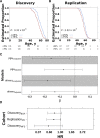A polygenic two-hit hypothesis for prostate cancer
- PMID: 36610996
- PMCID: PMC10086625
- DOI: 10.1093/jnci/djad001
A polygenic two-hit hypothesis for prostate cancer
Abstract
Prostate cancer is one of the most heritable cancers. Hundreds of germline polymorphisms have been linked to prostate cancer diagnosis and prognosis. Polygenic risk scores can predict genetic risk of a prostate cancer diagnosis. Although these scores inform the probability of developing a tumor, it remains unknown how germline risk influences the tumor molecular evolution. We cultivated a cohort of 1250 localized European-descent patients with germline and somatic DNA profiling. Men of European descent with higher genetic risk were diagnosed earlier and had less genomic instability and fewer driver genes mutated. Higher genetic risk was associated with better outcome. These data imply a polygenic "two-hit" model where germline risk reduces the number of somatic alterations required for tumorigenesis. These findings support further clinical studies of polygenic risk scores as inexpensive and minimally invasive adjuncts to standard risk stratification. Further studies are required to interrogate generalizability to more ancestrally and clinically diverse populations.
© The Author(s) 2023. Published by Oxford University Press. All rights reserved. For permissions, please email: journals.permissions@oup.com.
Figures


References
-
- Schumacher FR, Al Olama AA, Berndt SI; Genetic Associations and Mechanisms in Oncology (GAME-ON)/Elucidating Loci Involved in Prostate Cancer Susceptibility (ELLIPSE) Consortium. Association analyses of more than 140,000 men identify 63 new prostate cancer susceptibility loci. Nat Genet. 2018;50(7):928-936. - PMC - PubMed

